实验3 类与对象的设计
java面向对象实验三 类与对象编程—类与对象基础

}
⒉实验测试结果:
实验结果及分析
实验结果:
(1)成功输出平均成绩和总成绩。
(2)创建四个学生对象,并成功输出学生信息。
教师评阅
System.out.println(name+"的平均成绩"+(java+c+db)/3.0);
}
voidsum(){
System.out.println(name+"的总成绩为"+(java+c+db));
}
}
publicclassTest{
publicstaticvoidmain(String []args){
classUndergraduate {
Stringname;
intcourse;
Stringeducation="本科";
Undergraduate(String _name,int_course) {
name= _name;
course= _course;
}
String getGrade() {
return("良好");
if(course>= 70)
return("一般");
if(course>= 60)
return("及格");
return("不及格");
实验过程及步骤
}
}
publicclassTest {
publicstaticvoidmain(String[] args) {
Underg("张三", 68);
类与对象的实验报告

类与对象的实验报告类与对象的实验报告引言:在计算机科学领域,类与对象是面向对象编程(Object-Oriented Programming,简称OOP)的核心概念之一。
类是一种抽象的数据类型,用于描述具有相同属性和行为的对象集合。
对象则是类的实例,具体化了类的属性和行为。
本实验旨在通过编写一个简单的类与对象的程序,深入理解类与对象的概念及其在编程中的应用。
实验过程:1. 定义一个类:在这个实验中,我们以动物为例,定义了一个名为Animal的类。
该类具有以下属性和行为:- 属性:名称、年龄、种类- 行为:吃、睡、叫2. 创建对象:在主程序中,我们创建了两个Animal对象,分别代表一只狗和一只猫。
通过调用构造函数,为对象的属性赋值。
3. 调用对象的方法:我们通过调用对象的方法,模拟了动物的行为。
例如,我们调用了eat()方法,让动物吃东西;调用了sleep()方法,让动物睡觉;调用了make_sound()方法,让动物发出叫声。
4. 修改对象属性:我们还演示了如何修改对象的属性。
通过调用set_age()方法,我们改变了动物的年龄;通过调用set_type()方法,我们改变了动物的种类。
实验结果:通过运行程序,我们观察到以下结果:- 狗的名称是"旺财",年龄是3岁,种类是"狗"。
狗吃骨头,睡觉时打呼噜,发出汪汪的叫声。
- 猫的名称是"咪咪",年龄是2岁,种类是"猫"。
猫吃鱼,睡觉时打呼噜,发出喵喵的叫声。
- 经过修改后,狗的年龄变为5岁,种类变为"藏獒";猫的年龄变为3岁,种类变为"波斯猫"。
讨论与分析:通过这个实验,我们深入理解了类与对象的概念及其在编程中的应用。
类是一种抽象的模板,用于描述具有相似属性和行为的对象集合。
对象是类的实例,具体化了类的属性和行为。
通过定义类和创建对象,我们可以更好地组织和管理程序的代码。
实验三 类与对象
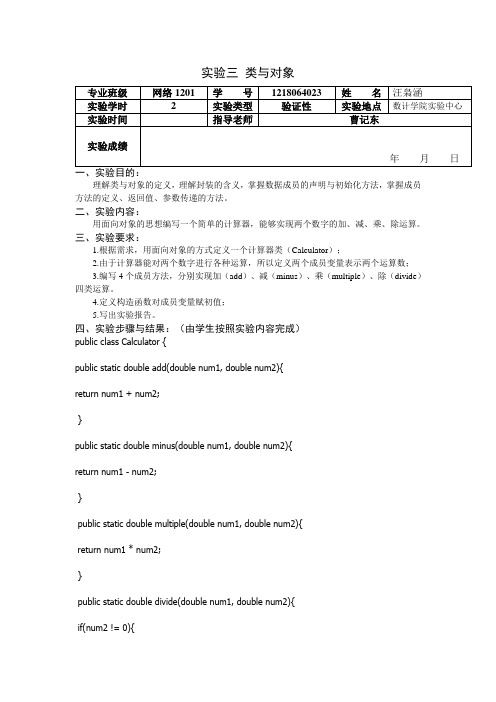
实验三类与对象专业班级网络1201 学号1218064023 姓名汪枭涵实验学时 2 实验类型验证性实验地点数计学院实验中心实验时间指导老师曹记东实验成绩年月日一、实验目的:理解类与对象的定义,理解封装的含义,掌握数据成员的声明与初始化方法,掌握成员方法的定义、返回值、参数传递的方法。
二、实验内容:用面向对象的思想编写一个简单的计算器,能够实现两个数字的加、减、乘、除运算。
三、实验要求:1.根据需求,用面向对象的方式定义一个计算器类(Calculator);2.由于计算器能对两个数字进行各种运算,所以定义两个成员变量表示两个运算数;3.编写4个成员方法,分别实现加(add)、减(minus)、乘(multiple)、除(divide)四类运算。
4.定义构造函数对成员变量赋初值;5.写出实验报告。
四、实验步骤与结果:(由学生按照实验内容完成)public class Calculator {public static double add(double num1, double num2){return num1 + num2;}public static double minus(double num1, double num2){return num1 - num2;}public static double multiple(double num1, double num2){return num1 * num2;}public static double divide(double num1, double num2){if(num2 != 0){return num1/num2;}return -1;//除数为0,错误}public static void main(String args[]){System.out.println("加法:15 + 5 = " + add(15, 5));System.out.println("减法:15 + 5 = " + minus(15, 5));System.out.println("乘法:15 + 5 = " + multiple(15, 5));System.out.println("除法:15 + 5 = " + divide(15, 5));}}实验结果:总结:通过本次实验,了解了java的开发环境,掌握了NetBeans的使用方法,同时对一些简单的基本JA V A语言的有了进一步的了解和掌握,对JA V A的一些基本语法也明白的很多,但是因为一开始在语法上存在一定的应用缺陷所以导致在实验的过程遇到了一些问题,最终通过和同学的讨论顺利解决了问题。
实验三 类与对象(1)——耿祥义

定义Test3_2类,在其中编写一个main方法,在其中创建分别创建三个类的对象,并显示Circle,Lader,Trangle对象的属性信息和面积值。对Trangle对象,还要显示其是否可以构成三角形的信息。
(二)使用修饰符
有时需要公开一些变量和方法,有时需要禁止其他对象使用变量和方法,这时可以使用修饰符来实现这个目的。常用的修饰符如下。public,private,protected,package,static,final,transient,volatile
程序功能:通过两个类StaticDemo、KY2_4说明静态变量/方法与实例变量/方法的区别。
③将class CCircle中的变量double pi; double radius;加上private修饰符,进行编译会出现什么问题,为什么?
④将void setCircle(double r, double p),double getRadius()和double getCircleArea()加上修饰符static,重新编译会出现什么问题?仍用static,怎样修改别的地方来纠正这个错误?在main中引用这些方法时不用创建对象则怎样引用?
程序功能:描述一个圆类,其主要属性为半径,还有一个非常重要的常量是圆周率。该圆可以求出面积,可以设置半径和取得半径大小。
class CCircle
{ double pi;
double radius;
double getRadius()
{ return radius;
}
void setCircle(double r, double p)
void aaa()
面向对象程序设计(C++)实验一--类和对象

实验一类和对象一、实验目的:掌握类的设计和对象的创建及相关知识点如对象数组、类聚合、友元函数、静态成员。
二、实验内容:1、设计圆类,求两个圆的位置关系;2、设计圆类和直线类,求直线与圆的位置关系;3、设计学生类,求某班学生成绩的最高分、最低分及平均分;4、设计部门类和教师类,其中部门类成员为教师类的子对象;5、设计家庭银行账户类,其中账户资金为静态数据成员,为家庭成员共享;6、设计复数类,友元函数实现复数的加减。
三、实验过程:1、根据实验题目确定需要设计哪些类、各类中包含哪些数据成员和函数成员,设计各成员的访问权限,设计数据成员的数据类型,设计函数成员的函数原型;2、给出类设计的程序实现,特别要注意重载构造函数的实现;3、在主函数中完成题目中的逻辑,一般情况下需要创建相关类的对象,通过对象对成员函数的调用或者通过对象指针对成员函数的调用完成相应的功能。
四、参考程序代码:1、设计圆类,求两个圆的位置关系#include <iostream>#include <math.h>using namespace std;class Circle{private:float a,b,r;public:Circle(float c,float d,float e){a=c;b=d; r=e;}friend void position(Circle &,Circle &);};void position(Circle &c1,Circle &c2){float n,m,p;p=sqrt((c1.a-c2.a)*(c1.a-c2.a)+(c1.b-c2.b)*(c1.b-c2.b)); n=fabs(c1.r-c2.r);m=c1.r+c2.r;if(p>m)cout << "相离";if(p==m)cout << "相切";if(p<m)cout << "相交";}int main(){float a,b,c,d,e,f;cin >> a >> b >> c >> d >> e >> f ;Circle c1(a,b,c),c2(d,e,f);position(c1,c2);return 0;}运行结果:2、设计圆类和直线类,求直线与圆的位置关系#include<iostream>#include<math.h>using namespace std;class Circle//圆类{private:float x,y,r;public:Circle(float a,float b,float c) {x=a;y=b;r=c;}float getx(){return x;}float gety(){return y;}float getr(){return r;}};class Line//直线类{private:float a,b,c;public:Line(float x,float y,float z){a=x;b=y;c=z;}void position(Circle c1){float d=fabs(a*c1.getx()+b*c1.gety()+c)/sqrt(a*a+b*b) ;//圆心到直线的距离if(d<c1.getr())cout << "相交";if((d-c1.getr())<0.000001)cout << "相切";cout << "相离";}};int main(){Line l1(3,3,4);//创建直线对象Circle c1(-23,3,7);//创建圆对象l1.position(c1);return 0;}运行结果:3、设计学生类,求某班学生成绩的最高分、最低分及平均分#include <iostream>#include <string.h>using namespace std;class Student{private:char name[20],xuehao[20];float math;public:Student(){}Student(char *na,char *xu,float ma):math(ma) {strcpy(name,na);strcpy(xuehao,xu);}void set(char *na,char *xu,float ma){math=ma;strcpy(name,na);strcpy(xuehao,xu);}char *get_name(){return name;}char *get_xuehao(){return xuehao;float get_math(){return math;}};void max_min(Student stu[],int n){Student max,min;max=min=stu[0];for(int i;i<n;i++){if(stu[i].get_math()>max.get_math())max=stu[i];if(stu[i].get_math()<min.get_math())min=stu[i];}cout << "学生成绩最高:" << max.get_name() << "," << max.get_xuehao() << "," << max.get_math() << endl;cout << "学生成绩最低:" << min.get_name() << "," << min.get_xuehao() << "," << min.get_math() << endl;}void ave(Student stu[],int n){float sum=0;for(int i=0;i<n;i++){sum=sum+stu[i].get_math();cout << "ave=" << sum/n;}int main(){char na[20],xu[20];float ma;Student stu[20];int n;cout << "请输入学生总人数"; cin >> n;for(int i=0;i<n;i++){cin >> na >> xu >> ma ; stu[i].set(na,xu,ma); }max_min(stu,n);ave(stu,n);return 0;}运行结果:4、设计部门类和教师类,其中部门类成员为教师类的子对象#include <iostream>#include <string.h>using namespace std;class Department{private:int dep_num;char dep_master[20];char dep_name[20];public:Department(){}Department(int num,char *ma,char *na){dep_num=num;strcpy(dep_master,ma);strcpy(dep_name,na);}void show(){cout << dep_num << "," << dep_master << "," << dep_name ; }};class Teacher{private:char name[20];char haoma[20];Department dep;public:Teacher(char *n,char *nu,int num,char *ma,char *na):dep(num,ma,na) {strcpy(name,n);strcpy(haoma,nu);}void show(){dep.show();cout << "," << name << "," << haoma << endl;}};int main(){Teacher hp("wanghai","12345",6,"kiki","computer");hp.show();return 0;}运行结果:5、设计家庭银行账户类,其中账户为静态数据成员,为家庭成员共享#include <iostream>#include <string.h>using namespace std;class Familymember//家庭成员类{private:char membername[10];//成员名public:static float account;//共享账户资金 Familymember(char *name);static void save(float money);//存钱 static void pay(float money);//支出 static void show(); //显示账户余额};float Familymember::account=0;Familymember::Familymember(char *name) {strcpy(membername,name);}void Familymember:: save(float money) {account= account+money;}void Familymember:: pay(float money){account= account-money;}void Familymember:: show(){cout<<account<<endl;}int main()//主函数{ Familymember husband("wang"),wife("Li"); husband.save(10000);wife.pay(3000);wife.save(5000);wife.show();husband. show();}运行结果:6、设计复数类,友元函数实现复数的加减#include <iostream>using namespace std;class Fushu{private:float ss,xs;public:Fushu(){}Fushu(float a,float b){ss=a;xs=b;}friend Fushu jiafa(Fushu &f1,Fushu &f2){return Fushu((f1.ss+f2.ss),(f1.xs+f2.xs)); }friend Fushu jian(Fushu &f1,Fushu &f2){return Fushu((f1.ss-f2.ss),(f1.xs-f2.xs)); }void show(){cout << ss << " + " << xs << "i" << endl; }};int main(){Fushu f1(2,3),f2(4,5);Fushu f3,f4;f3=jiafa(f1,f2);f4=jian(f1,f2);f3.show();f4.show();return 0;}运行结果:。
《python语言实训》面向对象程序设计实验
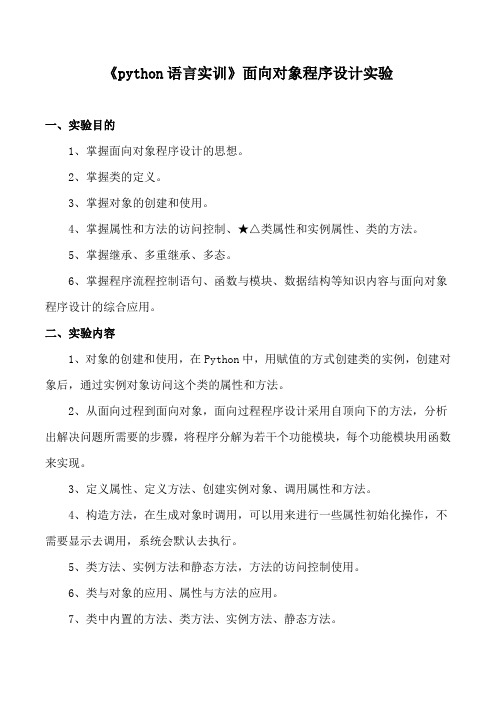
《python语言实训》面向对象程序设计实验一、实验目的1、掌握面向对象程序设计的思想。
2、掌握类的定义。
3、掌握对象的创建和使用。
4、掌握属性和方法的访问控制、★△类属性和实例属性、类的方法。
5、掌握继承、多重继承、多态。
6、掌握程序流程控制语句、函数与模块、数据结构等知识内容与面向对象程序设计的综合应用。
二、实验内容1、对象的创建和使用,在Python中,用赋值的方式创建类的实例,创建对象后,通过实例对象访问这个类的属性和方法。
2、从面向过程到面向对象,面向过程程序设计采用自顶向下的方法,分析出解决问题所需要的步骤,将程序分解为若干个功能模块,每个功能模块用函数来实现。
3、定义属性、定义方法、创建实例对象、调用属性和方法。
4、构造方法,在生成对象时调用,可以用来进行一些属性初始化操作,不需要显示去调用,系统会默认去执行。
5、类方法、实例方法和静态方法,方法的访问控制使用。
6、类与对象的应用、属性与方法的应用。
7、类中内置的方法、类方法、实例方法、静态方法。
8、继承与多态的应用、面向对象程序设计案例的应用。
9、Python程序控制结构、数据结构、函数与模块与面向对象程序设计方法的综合案例。
三、主要实验设备及器材1、计算机终端1套(配备Windous10系统或Windows7系统,英特尔i5及以上的处理器,4G以上内存,256G硬盘)。
2、多媒体教学设备1套。
3、网络设备套件1套。
4、Python软件、PyCharm软件、Anaconda软件等Python软件1套。
四、实验步骤(1)演示性实验教师利用多媒体等设备,对本章节的知识在Python语言的相关软件上进行演练。
(2)验证性实验学生指对Python的语言对象有了一定了解,并提出自己的相关问题,然后学生利用实验室的电脑设备解决问题。
(3)设计性实验设计程序以解决金融工程中的计量分析问题。
2、实验步骤(1)Python的Car对象的创建。
(2)在精灵宝可梦游戏中创建小火龙角色,对给出的各个属性进行迭代和私有化。
初中化学实验分类教案
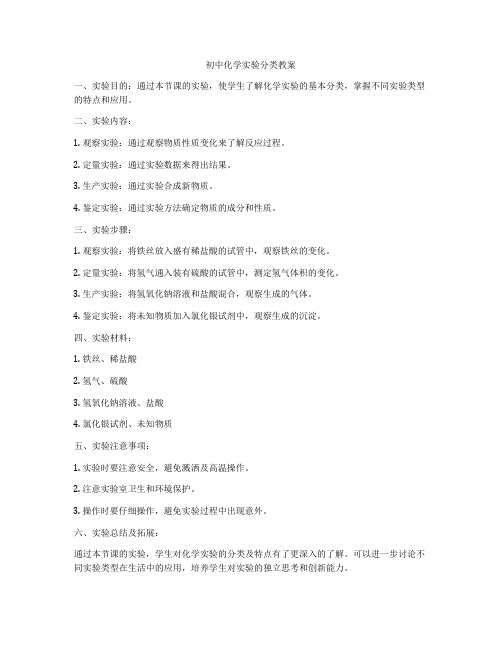
初中化学实验分类教案
一、实验目的:通过本节课的实验,使学生了解化学实验的基本分类,掌握不同实验类型的特点和应用。
二、实验内容:
1. 观察实验:通过观察物质性质变化来了解反应过程。
2. 定量实验:通过实验数据来得出结果。
3. 生产实验:通过实验合成新物质。
4. 鉴定实验:通过实验方法确定物质的成分和性质。
三、实验步骤:
1. 观察实验:将铁丝放入盛有稀盐酸的试管中,观察铁丝的变化。
2. 定量实验:将氢气通入装有硫酸的试管中,测定氢气体积的变化。
3. 生产实验:将氢氧化钠溶液和盐酸混合,观察生成的气体。
4. 鉴定实验:将未知物质加入氯化银试剂中,观察生成的沉淀。
四、实验材料:
1. 铁丝、稀盐酸
2. 氢气、硫酸
3. 氢氧化钠溶液、盐酸
4. 氯化银试剂、未知物质
五、实验注意事项:
1. 实验时要注意安全,避免溅洒及高温操作。
2. 注意实验室卫生和环境保护。
3. 操作时要仔细操作,避免实验过程中出现意外。
六、实验总结及拓展:
通过本节课的实验,学生对化学实验的分类及特点有了更深入的了解。
可以进一步讨论不同实验类型在生活中的应用,培养学生对实验的独立思考和创新能力。
《面向对象程序设计》实验指导书 (1-6个实验,含参考代码)要点
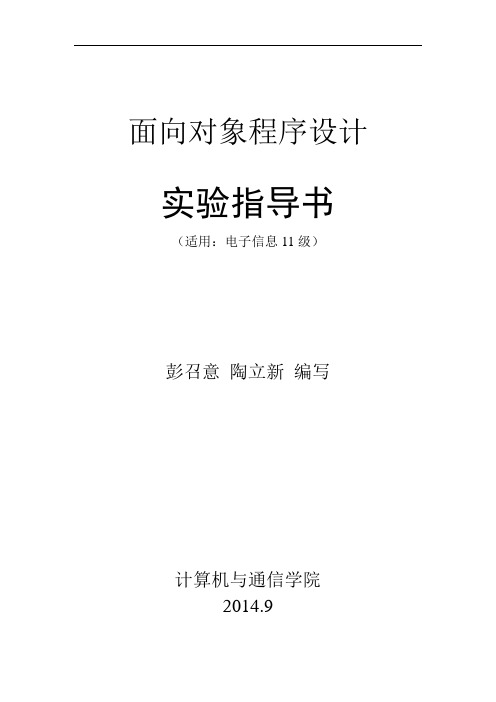
面向对象程序设计实验指导书(适用:电子信息11级)彭召意陶立新编写计算机与通信学院2014.9目录实验一 C++基础的应用 (1)实验二类和对象的应用 (3)实验三类的构造函数、析构函数的应用 (4)实验四友员和运算符重载 (5)实验五类的继承与派生 (6)实验六类的多态性与虚函数 (7)附录:各实验的程序代码 (8)实验一 C++基础的应用(实验课时:2 实验性质:设计)实验名称: C++基础的应用实验目的: (1)进一步学习VC++6.0开发环境及程序调试方法。
(2)练习C++函数的定义及使用;(3)练习C++数组的定义及使用;(4)练习C++指针的定义及使用;(5)练习C++结构体的定义及使用;(6)练习多文件的程序的编译和运行方法;实验设备:(1)硬件:个人微机(配置不低于:CPU为P4,主频1.6G,内存256MB,硬盘40GB);(2)软件:操作系统为WindowsXP(或2000、server2003等),工具软件为Visual C++6.0。
实验内容: (1)熟悉Visual C++6.0编译系统的常用功能,特别是debug调试功能;(2)编程1:编写一个程序c1.cpp,用来求2个或3个整数的最大数。
要求:用重载函数的方法来求最大数;函数原型:int max( int a, int b) 和int max( int a, int b,int c)。
(3)编程2:编写一个程序c2.cpp,求:a!+ b! + c!的值。
要求:使用递归函数。
主程序和函数分开到两个源程序文件中,分别进行编译后,再运行;(4)编程3:有一个3*4的矩阵,要求编程求出其中值最大的那个元素的值,以及其所在的行号和列号;(5)编程4:建立一个动态链表并进行输出和删除管理。
链表的每个节点为学生信息,包括:学号,姓名,性别,下一学生信息的指针。
程序的工作:(a)建立三个学生信息的节点,然后顺序输出该三个学生信息;(b)删除中间的节点,再顺序输出学生信息。
[实验报告]类和对象
![[实验报告]类和对象](https://img.taocdn.com/s3/m/b372f7ee0d22590102020740be1e650e52eacfce.png)
[实验报告]类和对象
一、实验目的
通过本次实验,了解抽象的一种程序设计概念“类”和“对象”,理解类之间的继承与多态性,以及封装对对象的各种属性和行为,实现软件对象模型与真实世界对象间的映射。
二、实验内容
1.定义类与对象
(1)类是代表一类实体的抽象。
它包含了一个共同拥有的结构和行为。
类是面向对象程序设计的基本元素。
(2)对象是一个实例。
它拥有一个特定于其类型的属性,并表现出对应的行为。
对象是程序中实际的可操作的元素。
2.类的成员
(1)类的成员可以是变量,函数,常量等等。
(2)变量:类的成员变量可以存储数据成员和提供给类的方法,这些变量被称为实例变量;类变量存储类及其对象的信息。
(3)函数:类的成员函数用于封装一定的行为或对对象的设置,它可以访问实例变量和类变量的值,以及实现一定的功能。
多态性是指一个类可以根据不同环境要求而采用不同的行为。
接口就是把数据和逻辑封装在一起的内部接口。
java类与对象实验报告

java类与对象实验报告Java类与对象实验报告一、引言Java是一种面向对象的编程语言,类和对象是Java编程的基本概念。
在本次实验中,我们将学习和掌握Java类和对象的概念、定义和使用方法,并通过实际的编程实验来加深对这些概念的理解。
二、实验目的1. 理解Java类和对象的概念;2. 学会定义和使用Java类;3. 掌握创建和操作Java对象的方法;4. 熟悉Java类和对象的相关语法和规范。
三、实验过程1. 类的定义在Java中,类是对象的模板,用于描述对象的属性和行为。
我们首先需要定义一个类,以便创建对象。
类的定义包括类名、属性和方法。
属性即对象的特征,方法即对象的行为。
2. 对象的创建通过使用关键字"new",我们可以创建一个类的对象。
对象是类的实例化,每个对象都有自己的属性和方法。
3. 对象的属性和方法对象的属性和方法可以通过对象名加点操作符来访问。
属性可以是基本类型或其他类的对象,方法可以是对象的行为或功能。
4. 构造方法构造方法是一种特殊的方法,用于创建对象时进行初始化操作。
构造方法的名称必须与类名相同,没有返回类型,可以有参数。
5. 封装性封装性是面向对象编程的重要特性之一,它将数据和方法封装在类中,对外部隐藏内部实现细节。
通过使用访问修饰符(private, public, protected)来控制属性和方法的访问权限。
6. 继承继承是面向对象编程的另一个重要特性,它允许我们创建一个新类,并从现有类中继承属性和方法。
通过使用关键字"extends"来实现继承。
7. 多态性多态性是面向对象编程的核心概念之一,它允许我们使用一个父类类型的引用来引用子类的对象。
通过方法的重写和重载来实现多态性。
四、实验结果通过本次实验,我们成功定义了一个Java类,并创建了多个对象。
我们可以通过对象名来访问对象的属性和方法,并对其进行操作。
我们还学习了构造方法的使用,以及封装性、继承和多态性的相关概念。
Java类与对象实验报告

实验报告一、实验项目:类与对象二、实验目的:1。
学会使用类来封装对象的属性和功能2. 掌握类变量与实例变量,以及类方法与实例方法的区别3。
掌握使用package和import语三、实验器材:计算机、Java编程软件JCreator四、实验原理(或仪器装置图):1. 类与对象类是组成Java程序的基本要素。
类封装了一类对象的状态和方法。
类是用来定义对象的模板。
类声明class 类名{类体}对象的声明一般格式为:类的名字对象名字;定义对象引用后,用new运算符完成对象的创建工作,分配存储空间,并对其初始化。
变量名=new 类名([构造方法实参表]);对象的使用访问成员的基本语法形式如下:对象名。
变量成员名对象名.方法成员名([实际参数表])2.成员变量和局部变量成员变量格式:[修饰符] 变量类型变量名[=初值];成员方法:格式:[修饰符]返回值的数据类型方法名(参数1,参数2,…){语句序列;return[表达式];}类中定义的变量是成员变量,而方法中定义的变量是局部变量。
3. 构造方法构造方法是一种特殊的方法,创建对象时被自动调用.与一般的方法不同,它没有返回值类型的说明,方法体中也不可以用return语句带回返回值。
构造方法的方法名与类名相同在构造方法中可以通过this关键字调用该类中其他的构造方法。
4。
包包是Java语言中有效地管理类的一个机制。
①通过关键字package声明包语句。
package 语句作为Java源文件的第一条语句,指明该源文件定义的类所在的包.package语句的一般格式为:package 包名;②import 语句:使用import 语句可以引入包中的类。
五、实验步骤及数据记录:1.定义一个圆柱体类Cylinder,并创建相应的对象,然后计算圆柱体的底面积与体积。
class Cylinder{double radius;int height;double pi=3.14;void area(){System。
c++程序设计类和对象实验总结

一、实验目的在本次C++程序设计实验中,主要目的是通过对类和对象的学习和掌握,进一步加深对C++程序设计语言的理解和应用。
通过具体的实验操作,提高学生的编程能力和解决问题的能力,培养学生的动手能力和团队协作精神。
二、实验内容1. 掌握类的概念和基本语法,包括类的定义、成员变量、成员函数等;2. 熟悉对象的概念和使用方法,了解对象的初始化和销毁;3. 学习类的继承和派生的知识,掌握继承与派生的语法和使用;4. 能够独立编写包含类和对象的程序,实现各种功能;5. 通过实践项目,提高自己的编程水平,锻炼解决问题的能力。
三、实验过程在实验过程中,首先我们需要了解类和对象的概念,理解类的定义和对象的创建方法。
编写简单的程序进行练习,例如创建一个包含学生信息的类,并实例化对象,调用成员函数来输出学生信息。
也需要深入学习类的继承和派生的知识,理解基类和派生类的关系,掌握虚函数的概念和使用方法。
在实验中,我们编写了多个实例程序来练习类的继承和派生,加深了对这一知识点的理解。
在实验过程中,我们还遇到了一些问题,例如在使用多重继承时需要特别注意类的构造和析构顺序,以及在使用虚函数时需要注意动态绑定的原理等。
通过解决这些问题,我们不断提高了自己的编程水平,加深了对C++语言的理解。
四、实验总结通过本次实验,我们深刻理解了类和对象的概念,掌握了类的定义和对象的创建方法。
在实验中,我们编写了多个功能丰富的程序,包括学生信息管理系统、图形类的继承等。
这些程序不仅巩固了所学的知识,也让我们感受到了编程的乐趣。
通过与同学的讨论和交流,我们也学到了很多新的知识和技巧。
本次实验对我们的帮助很大,让我们更深入地理解了C++程序设计语言,提高了我们的编程水平。
希望在以后的学习和实践中,能够进一步加深对类和对象的理解,不断提高自己的编程能力。
在本次的C++程序设计实验中,我们深入学习了类和对象的概念,并通过实际的编程练习加深了对C++程序设计语言的理解和应用。
类和对象实验报告
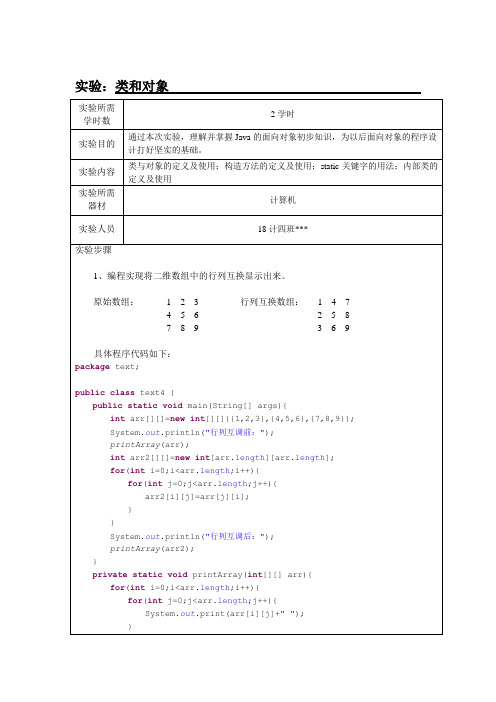
实验:类和对象System.out.println();}}}程序运行结果截图如下:2、用直接选择排序方法给一维数组{63,4,24,1,3,15}进行排序。
排序过程如下图所示:具体程序代码如下:package test;public class SelectSort {public static void main(String[] args){int array[]={63,4,24,1,3,15};SelectSort sorter=new SelectSort();sorter.sort(array);}public void sort(int[]array){int index;for(int i=1;i<array.length;i++){index=0;for(int j=1;j<=array.length-i;j++){if(array[j]>array[index]){index=j;}}int temp=array[array.length-i];array[array.length-i]=array[index];array[index]=temp;}showArray(array);}public void showArray(int[]array){System.out.println("选择排序的结果是:");for(int i:array){System.out.print(i+"\t");}System.out.println();}}程序运行结果截图如下:3、请编译下面程序段,如果出错,请写出出错原因,并修改程序使它正常运行。
public class Test4 {int x = 50;static int y =200 ;public static void method( ) {System.out.println(x+y);}public static void main(String[ ] args) {Test4.method( );}}具体程序代码如下:public class Test4 {static int x = 50;static int y =200 ;public static void method( ) {System.out.println(x+y);}public static void main(String[ ] args) {Test4.method( );}}程序运行结果截图如下:4、定义一个Father和Child类,并进行测试。
JAVA实验报告-实验3-类与对象-
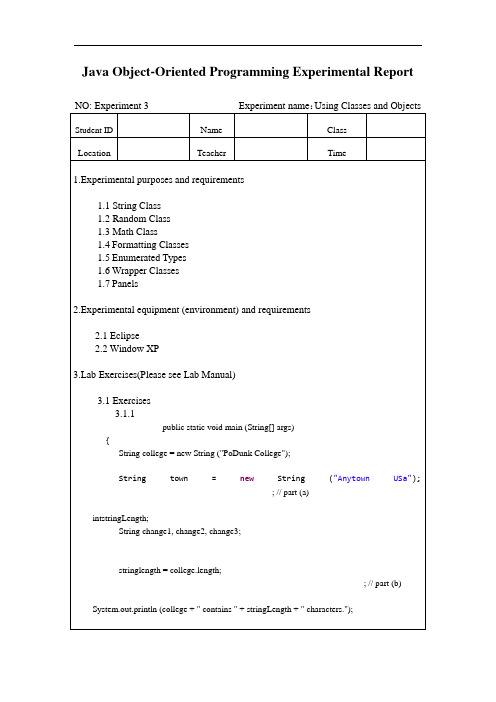
Java Object-Oriented Programming Experimental ReportSystem.out.println ("Your lucky numbers are " + lucky1 + ", " + lucky2+ ", and " + lucky3);}}3.2 Working with Strings(Choose to do)3.3 Rolling Dice3.4 Computing Distance3.5 formatting Output3.6 Playing with Cards(Choose to do)3.7 Experimenting with the Integer Class(Choose to do) 3.8 Nested Panels(1)宽度两倍(4)添加主界面宽度高度设定(5)添加MyPanels4.Experimental results and data processing5.Analysis and discussionScore: 6.Teacher ReviewsSignature:Date:Experimental Report List1Exercises1) Source code list3.3package test_java_03;import java.util.Random;public class point3_3 {public static void main(String[] args) {Random ger = newint lucky1, lucky2, lucky3;lucky1 = ger.nextInt(6)+1;lucky2 = (int)(ger.nextFloat()*6)+1;lucky3 = (int)(ger.nextFloat()*10)+20;System.out.print(lucky1+lucky2);}}3.4package test_java_03;import java.util.Scanner;public class point_3_4 {public static void main (String[] args){double x1, y1, x2, y2;double distance;Scanner scan = new Scanner(System.in);System.out.print ("Enter the coordinates of the first point " + "(put a space between them): ");x1 = scan.nextDouble();y1 = scan.nextDouble();System.out.print ("Enter the coordinates of the second point: ");x2 = scan.nextDouble();y2 = scan.nextDouble();doubley=Math.abs(y2-y1)*Math.abs(y2-y1),x=Math.abs(x2-x1)*Math.abs(x2-x1);double z=Math.sqrt(y+x);System.out.print("The distance between the two points is "+z);}}3.5package test_java_03;import java.util.*;import java.text.NumberFormat;import java.text.DecimalFormat;public class point_3_5 {public static void main (String[] args){final double OUNCES_PER_POUND = 16.0;double pricePerPound;double weightOunces;double weight;double totalPrice;Scanner scan = new Scanner(System.in);NumberFormat money=NumberFormat.getCurrencyInstance();DecimalFormat fmt=new DecimalFormat("0.#####");System.out.println ("Welcome to the CS Deli!!\n ");System.out.print ("Enter the price per pound of your item: ");pricePerPound = scan.nextDouble();System.out.print ("Enter the weight (ounces): ");weightOunces = scan.nextDouble();weight = weightOunces / OUNCES_PER_POUND;totalPrice = pricePerPound * weight;System.out.println("total price is:"+fmt.format(totalPrice));}}3.8(1)package test_java_03;import java.awt.*;import javax.swing.*;public class point_3_8 {public static void main (String[] args){JFrame frame = new JFrame ("Nested Panels");// Set up first subpanelJPanel subPanel1 = new JPanel();subPanel1.setPreferredSize (new Dimension(150, 100));subPanel1.setBackground (Color.green);JLabel label1 = new JLabel ("One");subPanel1.add (label1);// Set up second subpanelJPanel subPanel2 = new JPanel();subPanel2.setPreferredSize (new Dimension(150, 100));subPanel2.setBackground (Color.red);JLabel label2 = new JLabel ("Two");subPanel2.add (label2);JPanel subPanel3 = new JPanel();subPanel3.setPreferredSize (new Dimension(300, 100));subPanel3.setBackground (Color.black);JLabel label3 = new JLabel ("Three");subPanel3.add (label3);// Set up primary panelJPanel primary = new JPanel();primary.setBackground (Color.blue);primary.add (subPanel1);primary.add (subPanel2);primary.add (subPanel3);frame.getContentPane().add(primary);frame.pack();frame.setVisible(true);}}(4)package test_java_03;import java.awt.*;import javax.swing.*;public class point_3_8 {public static void main (String[] args){JFrame frame = new JFrame ("Nested Panels");// Set up first subpanelJPanel subPanel1 = new JPanel();subPanel1.setPreferredSize (new Dimension(150, 100));subPanel1.setBackground (Color.green);JLabel label1 = new JLabel ("One");subPanel1.add (label1);// Set up second subpanelJPanel subPanel2 = new JPanel();subPanel2.setPreferredSize (new Dimension(150, 100));subPanel2.setBackground (Color.red);JLabel label2 = new JLabel ("Two");subPanel2.add (label2);JPanel subPanel3 = new JPanel();subPanel3.setPreferredSize (new Dimension(300, 100));subPanel3.setBackground (Color.black);JLabel label3 = new JLabel ("Three");subPanel3.add (label3);// JPanel subPanel4 = new JPanel();// subPanel4.setPreferredSize(new Dimension(320,20));// subPanel4.setBackground(Color.orange);// JLabel label4 = new JLabel("My Panels");// subPanel4.add(label4);// Set up primary panelJPanel primary = new JPanel();primary.setBackground (Color.white);primary.setPreferredSize(new Dimension(320,260));//primary.add (subPanel4);primary.add (subPanel1);primary.add (subPanel2);primary.add (subPanel3);frame.getContentPane().add(primary);frame.pack();frame.setVisible(true);}}(5)package test_java_03;import java.awt.*;import javax.swing.*;public class point_3_8 {public static void main (String[] args){JFrame frame = new JFrame ("Nested Panels");// Set up first subpanelJPanel subPanel1 = new JPanel();subPanel1.setPreferredSize (new Dimension(150, 100));subPanel1.setBackground (Color.green);JLabel label1 = new JLabel ("One");subPanel1.add (label1);// Set up second subpanelJPanel subPanel2 = new JPanel();subPanel2.setPreferredSize (new Dimension(150, 100));subPanel2.setBackground (Color.red);JLabel label2 = new JLabel ("Two");subPanel2.add (label2);JPanel subPanel3 = new JPanel();subPanel3.setPreferredSize (new Dimension(300, 100));subPanel3.setBackground (Color.black);JLabel label3 = new JLabel ("Three");subPanel3.add (label3);JPanel subPanel4 = new JPanel();subPanel4.setPreferredSize(new Dimension(320,20));subPanel4.setBackground(Color.orange);JLabel label4 = new JLabel("My Panels");subPanel4.add(label4);// Set up primary panelJPanel primary = new JPanel();primary.setBackground (Color.white);primary.setPreferredSize(new Dimension(400,400));primary.add (subPanel4);primary.add (subPanel1);primary.add (subPanel2);primary.add (subPanel3);frame.getContentPane().add(primary);frame.pack();frame.setVisible(true);}}。
UML 新编实验指导书(实验三)
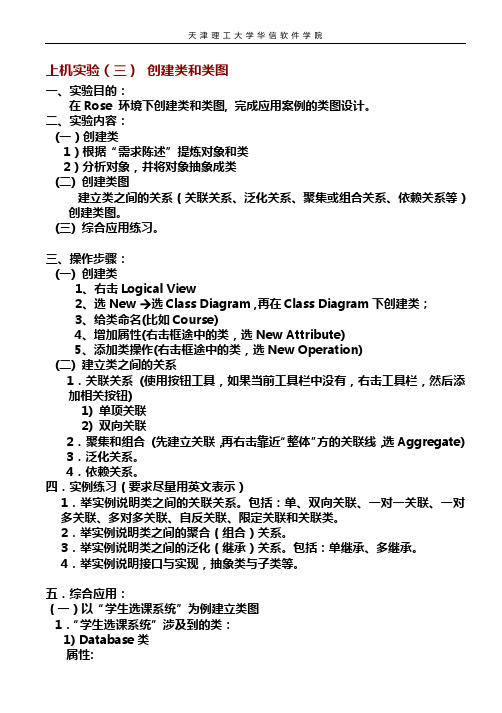
天津理工大学华信软件学院上机实验(三)创建类和类图一、实验目的:在Rose 环境下创建类和类图, 完成应用案例的类图设计。
二、实验内容:(一)创建类1)根据“需求陈述”提炼对象和类2)分析对象,并将对象抽象成类(二) 创建类图建立类之间的关系(关联关系、泛化关系、聚集或组合关系、依赖关系等)创建类图。
(三) 综合应用练习。
三、操作步骤:(一) 创建类1、右击Logical View2、选New 选Class Diagram ,再在Class Diagram下创建类;3、给类命名(比如Course)4、增加属性(右击框途中的类,选New Attribute)5、添加类操作(右击框途中的类,选New Operation)(二) 建立类之间的关系1.关联关系 (使用按钮工具,如果当前工具栏中没有,右击工具栏,然后添加相关按钮)1) 单项关联2) 双向关联2.聚集和组合 (先建立关联,再右击靠近“整体”方的关联线,选Aggregate) 3.泛化关系。
4.依赖关系。
四.实例练习(要求尽量用英文表示)1.举实例说明类之间的关联关系。
包括:单、双向关联、一对一关联、一对多关联、多对多关联、自反关联、限定关联和关联类。
2.举实例说明类之间的聚合(组合)关系。
3.举实例说明类之间的泛化(继承)关系。
包括:单继承、多继承。
4.举实例说明接口与实现,抽象类与子类等。
五.综合应用:(一)以“学生选课系统”为例建立类图1.“学生选课系统”涉及到的类:1) Database类属性:dbPath: String操作:(以下列出部分操作)Query Course() Add Course() Delete Course() Get dbPath() Set dbPath() ……2) Student类属性:studentID: Int studentName: String操作:get StudentID() set StudentID()get StudentName() set StudentName()3) Registrar类属性:registrarName: String regID: Int操作:get regID() set regID()get registrarName() set registrarName()4) Course类属性:courseID: Int courseName: Stringclassroom: String teacher: string操作:createCourse() destroyCourse() getName()setName() getCourseID() setCourseID() getTeacher() setTeacher()……5) Control类属性: (无)操作:verifyCourse() canAdd() queryCourse()confirmDelete() canSelect() queryAssociation() 6)Form类属性:(接口无属性)操作:getCourseInfo() showSuccessInfo() showConfirmPage()displayCourseList() querySelectCourse()2. 创建上述类之间的关系;① Student和Form之间-----单向关联(一对多)② Registrar和Form之间-----单向关联(一对多)③ Form和Course之间-----单向关联(一对多)④ Control和Course之间-----单向关联(一对多)⑤ Control和Form之间-----双向关联(一对多)⑥ Control和Database之间-----单向关联(一对一)3.完成类图(对象模型)的设计(以下是简化的类图参考图,详细的类图由同学们自己来完成。
实验报告模板——实验1:类和简单对象

实验报告模板——实验1:类和简单对象天津理⼯⼤学计算机与通信⼯程学院实验报告⾄学年第学期课程名称实验( 1 )实验名称类和简单对象实验时间学号姓名专业主讲教师辅导教师软件环境硬件环境实验⽬的(1)理解类和对象的概念;(2)掌握类与对象的定义⽅法;(3)理解类的成员的访问控制的含义,公有和私有成员的区别;(4)掌握构造函数和析构函数的含义与作⽤、定义⽅式和实现;(5)能够根据给定的要求定义类并实现类的成员函数;(6)掌握string类的使⽤⽅法(7)了解C++⾯向对象程序设计的基本思想、基本⽅法和基本步骤;(8)掌握MS Visual C++6.0调试C++程序的基本⽅法、基本步骤。
实验内容(应包括实验题⽬、实验要求、实验任务等)1.输⼊下列程序,按要求进⾏实验,并记录实验的结果。
2.根据注释语句的提⽰实现类Date的成员函数,并将完整的程序编译、连接成功以保证程序能够正确运⾏。
3.下⾯是⼀个计算器类的定义,请完成该类的成员函数的实现,并设计⼀个主函数使⽤该类和相关成员函数以测试该类设计的正确性。
4.定义⼀个类ClsName,要求该类设计如下:(1)该类有两个整型数据成员x和y;(2)为该类重载三个不同的构造函数:分别为⽆参数、带⼀个参数和带两个参数的构造函数,要求在构造函数中输出必要的信息以⽰区别;(3)设计2个成员函数⽤来读取数据成员x和y;(4)设计2个成员函数⽤来设置数据成员x和y;(5)设计1个成员函数⽤来在屏幕上打印输出数据成员x和y;(6)在main()函数中⽤三个不同的构造函数创建3个对象,并使⽤所有的成员函数对这些对象进⾏必要的操作。
5.建⽴类cylinder,包括两个数据成员radius和height,分别表⽰圆柱体的半径和⾼度, cylinder类的构造函数被传递了两个double值来初始化这两个成员;定义成员函数area()和volume⽤来求圆柱体的表⾯积和体积,定义成员函数print()打印cylinder 类的相关信息。
《面向对象程序设计》实验指导书
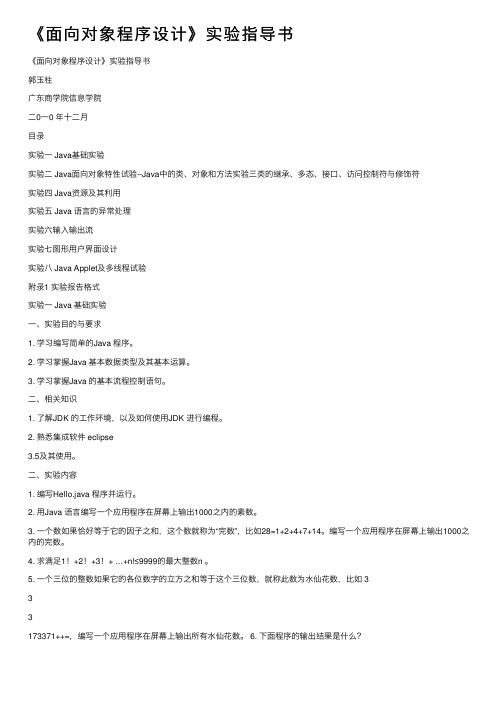
《⾯向对象程序设计》实验指导书《⾯向对象程序设计》实验指导书郭⽟柱⼴东商学院信息学院⼆0⼀0 年⼗⼆⽉⽬录实验⼀ Java基础实验实验⼆ Java⾯向对象特性试验--Java中的类、对象和⽅法实验三类的继承、多态、接⼝、访问控制符与修饰符实验四 Java资源及其利⽤实验五 Java 语⾔的异常处理实验六输⼊输出流实验七图形⽤户界⾯设计实验⼋ Java Applet及多线程试验附录1 实验报告格式实验⼀ Java 基础实验⼀、实验⽬的与要求1. 学习编写简单的Java 程序。
2. 学习掌握Java 基本数据类型及其基本运算。
3. 学习掌握Java 的基本流程控制语句。
⼆、相关知识1. 了解JDK 的⼯作环境,以及如何使⽤JDK 进⾏编程。
2. 熟悉集成软件 eclipse3.5及其使⽤。
⼆、实验内容1. 编写Hello.java 程序并运⾏。
2. ⽤Java 语⾔编写⼀个应⽤程序在屏幕上输出1000之内的素数。
3. ⼀个数如果恰好等于它的因⼦之和,这个数就称为“完数”,⽐如28=1+2+4+7+14。
编写⼀个应⽤程序在屏幕上输出1000之内的完数。
4. 求满⾜1!+2!+3!+ …+n!≤9999的最⼤整数n 。
5. ⼀个三位的整数如果它的各位数字的⽴⽅之和等于这个三位数,就称此数为⽔仙花数,⽐如 333173371++=,编写⼀个应⽤程序在屏幕上输出所有⽔仙花数。
6. 下⾯程序的输出结果是什么?实验⼆ Java⾯向对象特性试验-Java中的类、对象和⽅法⼀、实验⽬的与要求1. 掌握类的定义和使⽤。
2. 掌握对象的声明、创建和使⽤。
3. 掌握构造⽅法的定义和使⽤。
4. 掌握类⽅法(静态⽅法)和⾮类⽅法(⾮静态⽅法)的区别和使⽤。
5. 掌握成员变量和局部变量的区别和使⽤。
⼆、实验内容1. 编写⼀个Java程序,定义⼀个表⽰学⽣的类,类名Student,其成员变量有:学号、班级姓名、性别、年龄;成员⽅法:(1)获得班号(2)获得姓名(3)获得年龄(4)修改年龄;创建⼀个Student的对象,修改该对象的年龄,并输出该对象的年龄。
类与对象实验报告

类与对象实验报告类与对象实验报告引言在计算机科学领域,类与对象是面向对象编程的基本概念之一。
通过定义类,我们可以创建对象,从而实现对数据和行为的封装和抽象。
本实验旨在通过实际操作,深入理解类与对象的概念,并掌握其在程序设计中的应用。
实验目的1. 理解类与对象的概念和关系;2. 学会使用类和对象进行数据封装和行为抽象;3. 掌握类与对象在程序设计中的应用。
实验过程1. 类的定义在本实验中,我们以一个简单的学生类为例进行说明。
首先,我们需要定义一个类来表示学生。
在类的定义中,我们可以包含学生的属性和行为。
比如,学生的姓名、年龄、性别等属性,以及学生的学习、休息等行为。
2. 对象的创建在类的定义完成后,我们可以通过创建对象来实例化这个类。
对象是类的具体实例,每个对象都有自己的属性和行为。
比如,我们可以创建一个名为"张三"的学生对象,给该对象的属性赋值,并调用对象的方法来执行相应的行为。
3. 属性的访问和修改通过对象,我们可以访问和修改类中定义的属性。
比如,我们可以通过对象的属性来获取学生的姓名和年龄,并通过修改属性的值来更新学生的信息。
4. 方法的调用类中的方法是对行为的抽象,通过方法,我们可以对对象进行操作。
比如,我们可以调用学生对象的学习方法,来模拟学生的学习行为。
同时,方法也可以接受参数,以实现更加灵活的功能。
实验结果通过实验,我们成功创建了一个学生类,并实例化了一个学生对象。
通过对象的属性和方法,我们可以获取和修改学生的信息,同时也可以模拟学生的行为。
这样,我们就实现了对学生的封装和抽象,提高了程序的可读性和可维护性。
实验总结通过本次实验,我深刻理解了类与对象的概念和关系。
类是对一类具有相同属性和行为的对象的抽象,而对象则是类的具体实例。
通过定义类和创建对象,我们可以实现对数据和行为的封装和抽象,提高了程序的可读性和可维护性。
在实际的程序设计中,类与对象是非常重要的概念,对于理解和应用面向对象编程具有重要意义。
Java程序设计实验指导书(答案)

第Ⅰ部分:实验指导实验1:Java开发环境J2SE一、实验目的(1)学习从网络上下载并安装J2SE开发工具。
(2)学习编写简单的Java Application程序.(3)了解Java源代码、字节码文件,掌握Java程序的编辑、编译和运行过程。
二、实验任务从网络上下载或从CD-ROM直接安装J2SE开发工具,编写简单的Java Application程序,编译并运行这个程序。
三、实验内容1.安装J2SE开发工具Sun公司为所有的java程序员提供了一套免费的java开发和运行环境,取名为Java 2 SDK,可以从上进行下载。
安装的时候可以选择安装到任意的硬盘驱动器上,例如安装到C:\j2sdk1.4.1_03目录下。
教师通过大屏幕演示J2SE的安装过程,以及在Windows98/2000/2003下环境变量的设置方法。
2.安装J2SE源代码编辑工具Edit Plus教师通过大屏幕演示Edit Plus的安装过程,以及在Windows98/2000/2003操作系统环境下编辑Java 原程序的常用命令的用法。
3.编写并编译、运行一个Java Application程序。
创建一个名为HelloWorldApp的java Application程序,在屏幕上简单的显示一句话"老师,你好!"。
public class HelloWorldApp{public static void main(String[] args){System.out.println("老师,你好!");}}4.编译并运行下面的Java Application程序,写出运行结果。
1:public class MyClass {2:private int day;3:private int month;4:private int year;5:public MyClass() {6:day = 1;7:month = 1;8:year = 1900;9:}10:public MyClass(int d,int m,int y) {11:day = d;12:month = m;13:year = y;14:}15:public void display(){16:System.out.println(day + "-" + month + "-" + year);17:}18:public static void main(String args[ ]) {19:MyClass m1 = new MyClass();20:MyClass m2 = new MyClass(25,12,2001);21:m1.display();22:m2.display();23:}24:}运行结果:1-1-190025-12-2001实验2:Java基本数据类型一、实验目的(1)掌握javadoc文档化工具的使用方法。
- 1、下载文档前请自行甄别文档内容的完整性,平台不提供额外的编辑、内容补充、找答案等附加服务。
- 2、"仅部分预览"的文档,不可在线预览部分如存在完整性等问题,可反馈申请退款(可完整预览的文档不适用该条件!)。
- 3、如文档侵犯您的权益,请联系客服反馈,我们会尽快为您处理(人工客服工作时间:9:00-18:30)。
实验3 类与对象的设计专业:计算机科学与技术班级:10计本1班学号:姓名:实验地点:B102实验时间:2011/10/18 指导教师:李佐勇一、实验目的1.掌握声明类的方法,类和类成员的概念以及定义对象的方法;2.初步掌握利用类和对象的概念进行面向对象程序开发的方法;3.掌握构造函数、复制构造函数、析构函数的定义与使用;4.理解类的组合以及组合类构造函数的定义与使用。
二、实验环境一台PC机,Windows XP操作系统,Visual C++ 6.0开发环境。
三、实验内容1.Lab3_1.cpp:定义并实现一个矩形类(rectangle),其包含数据成员:长(length)、宽(width);函数成员:Show_length (显示矩形的长度)、Show_width (显示矩形的宽度)、Get_area (计算矩形的面积),除了上述成员函数,自行思考构造函数的设计。
2.Lab3_2.cpp:定义一个满足课后题目4-20要求的复数类Complex。
(注意:题目1、2选作一题即可)3.Lab3_3.cpp:定义CPU类,其包含数据成员:主频(frequency)、字长(wordlength)、倍频系数(coefficient)。
其中,字长为枚举型enum cpu_wordlen={W16,W32,W64,W128,W256},frequency为float型,coefficient为double型。
此外,类的公有成员函数run和stop分别提示CPU的运行与停止。
请给出构造函数(带参数、不带参数)、拷贝构造函数、析构函数、run、stop函数的定义,并在函数体内给出相应的提示便于观察程序运行过程,结合实验理解构造函数、拷贝构造函数、析构函数的调用顺序。
4.Lab3_4.cpp:请结合组合类的概念来描述计算机类Computer,其包含数据成员:芯片(cpu)、内存(ram)、显示器(monitor);函数成员:run:提示计算机正在运行、stop:提示计算机停止工作、用户自定义的构造函(有参数、无参数)。
芯片cpu是lab3_2中CPU类的对象,内存ram是单位为M的整型数据,显示器Monitor为屏幕对角线英寸的整型数据。
请写出类Computer的定义以及各个成员函数的实现,并在每个成员函数的函数体中给出相应的提示便于观察程序运行过程。
观察构造函数和复制构造函数的调用顺序。
四、实验记录1. #include<iostream>using namespace std;class rectangle{public:void show_length(float x);void show_width(float y);void get_area(float x,float y);private:float x,y;};inline void rectangle::show_length(float x){cout<<"The length of the rectangle is:"<<x<<endl;}inline void rectangle::show_width(float y){cout<<"The width of the rectangle is:"<<y<<endl;}inline void rectangle::get_area(float x,float y){cout<<"The area of the rectangle is:"<<x*y<<endl;}int main(){rectangle rec1;rec1.show_length(0);rec1.show_width(0);rec1.get_area(0,0);rectangle rec2;rec2.show_length(5);rec2.show_width(4);rec2.get_area(5,4);return 0;3.#include<iostream>using namespace std;enum cpu_wordlen {w16,w32,w64,w128,w256};enum cpu_wordlen wordlength;class CPU{public:CPU (float freq,double coef,enum cpu_wordlen wordl);CPU(){frequency=0;coeffcient=0;wordlength=cpu_wordlen(w16);}CPU(CPU&p);void run();void stop();float getF(){return frequency;}double getC(){return coeffcient;}enum cpu_wordlen getW(){return wordlength;}private:float frequency; double coeffcient; cpu_wordlen wordlength; };CPU::CPU(float freq,double coef,enum cpu_wordlen wordl){ frequency=freq;coeffcient=coef;wordlength=wordl;}CPU::CPU(CPU&p){frequency=p.frequency;coeffcient=p.coeffcient;wordlength=p.wordlength;}void run(){cout<<"CPU is running!"<<endl;}void stop(){cout<<"CPU stopped!"<<endl;}void fun1(){cout<<"Call a funcrion of parametres!"<<endl;}void fun2(){cout<<"Call a function without of parametres!"<<endl;}void fun3(CPU p){cout<<"frequency="<<p.getF()<<endl;}void fun4(CPU p){cout<<"coeffcient="<<p.getC()<<endl;}void fun5(CPU p){cout<<"wordlength="<<p.getW()<<endl;}int main(){fun1();CPU c1(25,5,w32);fun3(c1);fun4(c1);fun5(c1);run();fun2();CPU c2;fun3(c2);fun4(c2);fun5(c2);stop();return 0;}4.#include <iostream>#include <string>using namespace std;enum cpu_wordlen{W16,W32,W64,W128,W256};class cpu{public:cpu() {cout<<"调用CPU类的无形参构造函数"<<endl;} cpu(float fre,double coe,cpu_wordlen len){frequency=fre;coefficient=coe;length=len;cout<<"调用CPU类的带形参构造函数"<<endl;}cpu(cpu &a){frequency=a.frequency;coefficient=a.coefficient;length=a.length;cout<<"调用CPU类的复制构造函数"<<endl;}~cpu(){ cout<<"调用CPU类的析构函数"<<endl; }void print(){cout<<frequency<<coefficient<<length;}void run(){cout<<"CPU正在运行"<<endl;}void stop(){cout<<"CPU运行结束"<<endl;}private:float frequency;double coefficient;cpu_wordlen length;};class computer{public:computer(){cout<<"调用COMPUTER类的无形参构造函数"<<endl;}computer( cpu t,int r,int m );~computer(){ cout<<"调用COMPUTER类的析构函数"<<endl; }void run(){cout<<"COMPUTER正在运行,"<<endl; p.run();}void stop(){cout<<"COMPUTER运行结束"<<endl; p.stop();}private :cpu p;int ram;int monitor;};computer::computer(cpu t,int r,int m ):p(t) {ram=r;monitor=m;cout<<"调用COMPUTER类的带形参构造函数"<<endl;}void main(){cout<<"请分别输入电脑CPU的主频,倍频系数,字长以及其内存和显示器"<<endl;cout<<"其中枚举 cpu_wordlen{W16,W32,W64,W128,W256}"<<endl;float fre;double coeint ;int r,m,len;cpu CPU1;cpu_wordlen l;computer COM1;cin>>fre>>coeint>>len>>r>>m;l=cpu_wordlen(len);cpu CPU2(fre,coeint,l);computer COM2(CPU2,r,m);COM1.run();COM2.run();COM1.stop();COM2.stop();}五、思考题类与结构体的区别?答:除关键字不同外(class,struct)的唯一区别是,结构在默认情况下的成员是公共的,而类在默认情况下的成员是私有的。
